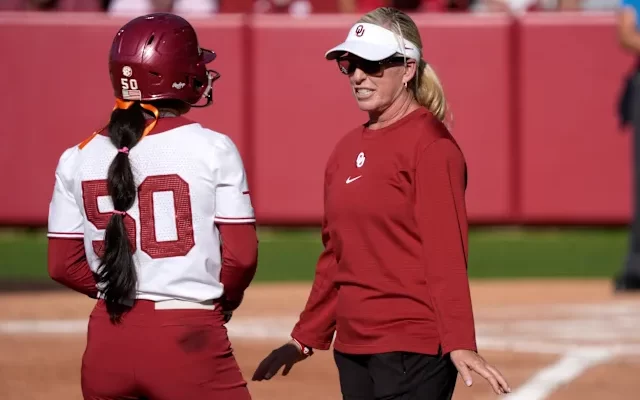Oklahoma softball’s Hannah Coor and Kadey Lee McKay have reportedly entered the transfer portal.
Oklahoma softball has long stood as a beacon of dominance in collegiate athletics, and the program’s immense success over the past decade has been anchored by a combination of elite talent, rigorous development, and unmatched team chemistry. The news that outfielders Hannah Coor and Kadey Lee McKay have reportedly entered the NCAA transfer portal marks a notable moment for the program, which is fresh off yet another Women’s College World Series appearance. While not every departure shakes the foundation of a dynasty, Coor and McKay’s decisions reflect broader trends within college softball and raise interesting questions about the future of Oklahoma’s outfield and the ever-evolving transfer landscape in NCAA athletics.
For fans of the Sooners, Hannah Coor is a familiar name. She arrived in Norman with considerable promise and contributed in meaningful ways during her time with the program. Known for her speed, defensive range, and ability to make contact at the plate, Coor provided depth in the outfield and was often praised by head coach Patty Gasso for her work ethic and commitment to the team. Though not always a regular starter, Coor’s moments on the field were impactful. She often found herself inserted into high-leverage situations where her speed could make a difference, whether as a pinch runner, a defensive substitution, or a situational hitter. In programs like Oklahoma’s, which are stacked with All-Americans and future Olympians, the role of depth players like Coor is vital—even if it often goes underappreciated by the public.
Kadey Lee McKay, on the other hand, is a younger player with substantial potential. A redshirt freshman in 2024, McKay didn’t see much playing time but was a name insiders were watching closely. Coming out of high school, she brought with her a reputation as a five-tool player—speed, arm strength, hitting for average, hitting for power, and defensive skill. While McKay’s opportunities to shine on the field in Norman were limited, she remained a valuable member of a team that thrives on competition and preparation. McKay’s decision to enter the portal suggests a desire to find a program where she can grow through more regular playing time and perhaps emerge as a primary contributor sooner rather than later.
The transfer portal has revolutionized collegiate athletics, and its impact on softball is no different. What once might have been a surprising decision is now increasingly commonplace. With the portal providing a more streamlined way for student-athletes to explore their options, players are empowered to seek out new opportunities that align with their individual goals. For players like Coor and McKay, who have both spent formative years in one of the most competitive environments in the country, transferring doesn’t necessarily signal disappointment or failure—it may simply reflect the realities of trying to find the best fit in a crowded roster.
Oklahoma’s roster is perennially packed with elite-level talent. With star outfielders like Jayda Coleman and Rylie Boone ahead of Coor and McKay on the depth chart, it’s understandable that opportunities might have been scarce. Coleman, one of the premier players in college softball, has anchored Oklahoma’s outfield with her acrobatic catches, strong arm, and top-of-the-order production at the plate. Boone, similarly, has carved out her place with exceptional fielding instincts and clutch hitting in key postseason moments. With players of that caliber logging the majority of innings in the outfield, younger or less-experienced players must often wait their turn or find other ways to contribute.
That context makes Coor and McKay’s departures understandable from a competitive standpoint. The decision to transfer is rarely made lightly, especially in a program as successful as Oklahoma’s. It likely reflects their desire to compete for starting roles and develop as everyday players—goals that can be difficult to achieve on a roster so loaded with All-American talent. For Coor, who has already spent several seasons in Norman, the move could represent her final opportunity to become a key player elsewhere before concluding her collegiate career. For McKay, who is younger and still has several years of eligibility left, the decision might be about setting the foundation for the future in a program where she can be central to the team’s plans.
Oklahoma fans might be tempted to worry about what these transfers mean in terms of depth, but the program is built to absorb losses like these without missing a beat. Patty Gasso has constructed a culture of excellence that attracts top-tier recruits year after year. The Sooners continue to bring in the nation’s best high school talent, and they’ve shown a remarkable ability to not only reload but also to elevate players who were previously in supporting roles. With incoming freshmen and other transfers likely to join the team, Oklahoma will once again be a national title contender in 2025.
However, it’s worth taking a moment to appreciate what players like Coor and McKay represent. They are reminders that building a championship team involves more than just collecting stars. It involves fostering a culture where every player, regardless of their role on game day, feels valued and prepared to contribute. Both players have spent countless hours training, practicing, supporting teammates, and upholding the standard of excellence that Oklahoma softball is known for. Their contributions, even if not always highlighted on national broadcasts, have been essential to maintaining the program’s identity and success.
For Coor, transferring could be an opportunity to finally be a starter, to lead an outfield, and to mentor younger players in the way she was mentored during her time at Oklahoma. Her experience in a championship-caliber environment makes her an incredibly valuable asset to any program that lands her. Her speed and situational awareness could allow her to thrive in a system that gives her more consistent opportunities to shine.
McKay, too, will be a highly sought-after player in the portal. With strong fundamentals, high school pedigree, and untapped potential, she represents an exciting development project for a program willing to invest in her growth. In many ways, her decision to transfer could lead to a breakout in the next few seasons. The right program with the right developmental resources and need for a young outfielder could turn McKay into a standout player by the time she’s an upperclassman.
The broader implications for Oklahoma are less about any immediate loss of talent and more about roster dynamics. Softball rosters are finite, and scholarship management is always a consideration, especially in elite programs. The departures of Coor and McKay could free up room for incoming players or transfers from other programs. Oklahoma has not shied away from bringing in key transfer pieces in recent years, with players like Tiare Jennings, Alyssa Brito, and others stepping into major roles after arriving from other schools.
In the age of the transfer portal, college softball is fluid. Player movement is now a part of the game’s fabric, and coaching staffs must adapt quickly. The staff in Norman has shown they’re more than capable of navigating this new reality. That said, player departures always come with emotional weight—for teammates, coaches, and fans alike. These athletes spend years together training, traveling, and competing. The bonds formed are significant, and seeing teammates leave can be difficult, even if everyone understands the reasons.
For fans of the sport, Coor and McKay’s entries into the portal are storylines worth following. Their next chapters could see them blossom into stars, and it’s always compelling to watch players grow in new environments. Their journeys also reinforce the idea that success in college softball isn’t a straight line. It’s winding, filled with adjustments and decisions that reflect the personal goals of the athletes themselves.
It’s also worth noting that while Oklahoma loses two players, their departure opens opportunities for others on the roster who have been waiting for their chance. Whether it’s a highly touted freshman stepping into a bigger role or a returning player who’s been developing behind the scenes, this is part of the program’s cyclical nature. Patty Gasso’s ability to manage that transition is one of the many reasons the Sooners continue to be the standard-bearer for excellence in college softball.
As for Coor and McKay, they leave behind a legacy of dedication and professionalism. Even if they weren’t the most high-profile players on the roster, they were part of a team that chased championships and set a standard for what it means to be a Sooner. Their names will now appear on the transfer portal tracker, and soon, news of their next destinations will emerge. Wherever they go, they carry with them the invaluable experience of having trained, competed, and developed in one of the most competitive softball environments in the country.
Oklahoma will move forward, as it always does, with a new crop of athletes ready to take the field. Coor and McKay will seek out new opportunities that better align with their personal and athletic goals. And the broader college softball world will continue to evolve, shaped in part by stories like theirs—of players who chase their dreams, adapt to change, and remind us that the sport is as much about growth and opportunity as it is about championships.



